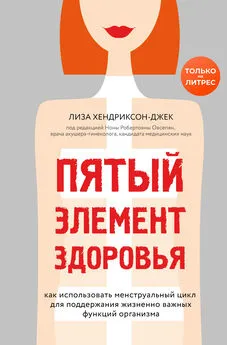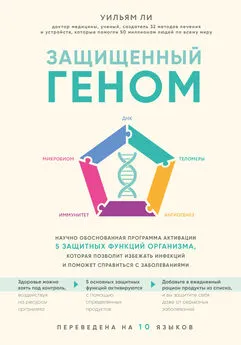Лиза Хендриксон-Джек - Пятый элемент здоровья. Как использовать менструальный цикл для поддержания жизненно важных функций организма
- Название:Пятый элемент здоровья. Как использовать менструальный цикл для поддержания жизненно важных функций организма
- Автор:
- Жанр:
- Издательство:Литагент 5 редакция
- Год:2020
- Город:Москва
- ISBN:978-5-04-104425-1
- Рейтинг:
- Избранное:Добавить в избранное
-
Отзывы:
-
Ваша оценка:
Лиза Хендриксон-Джек - Пятый элемент здоровья. Как использовать менструальный цикл для поддержания жизненно важных функций организма краткое содержание
«Почти» – потому что у женщин есть пятый показатель здоровья, на который, к сожалению, все еще мало кто обращает внимание, – это менструальный цикл. Короткий или длинный, регулярный или непредсказуемый – цикл может быть очень разным, и каждый его параметр, каждое изменение служат индикатором той или иной проблемы в организме. Планируете вы беременность или нет, овуляция имеет значение для поддержания здоровья.
Автор этой книги расскажет, что именно влияет на состояние менструального цикла, и научит вас составлять его график для максимально точного и удобного отслеживания различных изменений и контроля здоровья.
Пятый элемент здоровья. Как использовать менструальный цикл для поддержания жизненно важных функций организма - читать онлайн бесплатно ознакомительный отрывок
Интервал:
Закладка:
25. Strauss, Jerome F., and Robert L. Barbieri (2009). Yen & Jaffe’s Reproductive Endocrinology: Physiology, Pathophysiology, and Clinical Management, 6th edition. Philadelphia, PA: Elsevier: 165–171.
26. Odeblad, Erik. “The discovery of different types of cervical mucus and the Billings Ovulation Method.” Bulletin of the Natural Family Planning Council of Victoria 21, no. 3 (1994): 8–13; Moghissi, Kamran S. “The function of the cervix in fertility.” Fertility and Sterility 23, no. 4 (1972): 295–306.
27. Strauss, Jerome F., and Robert L. Barbieri (2009). Yen & Jaffe’s Reproductive Endocrinology: Physiology, Pathophysiology, and Clinical Management, 6th edition. Philadelphia, PA: Elsevier, 174–178.
28. Aspillaga, Margaret O., Paul G. Whittaker, Christina E. Grey, and Tom Lind. “Endocrinologic events in early pregnancy failure.” American Journal of Obstetrics and Gynecology 147, no. 8 (1983): 903–908; McNeilly, A.S., J. Kerin, I.A. Swanston, T.A. Bramley, and D.T. Baird. “Changes in the binding of human chorionic gonadotrophin/luteinizing hormone, follicle-stimulating hormone and prolactin to human corpora lutea during the menstrual cycle and pregnancy.” Journal of Endocrinology 87, no. 3 (1980): 315–325; Tuckey, Robert C. “Progesterone synthesis by the human placenta.” Placenta 26, no. 4 (2005): 273–281.
29. Strauss, Jerome F., and Robert L. Barbieri (2009). Yen & Jaffe’s Reproductive Endocrinology: Physiology, Pathophysiology, and Clinical Management, 6th edition. Philadelphia, PA: Elsevier, 174–178.
30. Brucker, Mary C. (2015). Pharmacology for Women’s Health. Jones & Bartlett Publishers: 372–373.
31. Odeblad, Erik. “The functional structure of human cervical mucus.” Acta Obstetricia et Gynecologica Scandinavica 47, no. S1 (1968): 57–79.
32. Odeblad, Erik. “The discovery of different types of cervical mucus and the Billings Ovulation Method.” Bulletin of the Natural Family Planning Council of Victoria 21, no. 3 (1994):13.
33. Там же,1–31.
34. Там же, 13.
35. Odeblad, E. “Investigation on the physiological basis for fertility awareness method.” Bulletin of the Ovulation Method Research and Reference Centre of Australia 29, no. 1 (2002): 2–11.
36. Pommerenke, W.T. “Cyclic changes in the physical and chemical properties of cervical mucus.” American Journal of Obstetrics and Gynecology 52, no. 6 (1946): 1023–1031; Moghissi, Kamran S. “The function of the cervix in fertility.” Fertility and Sterility 23, no. 4 (1972): 295–306; Daunter, B., and C. Counsilman. “Cervical mucus: its structure and possible biological functions.” European Journal of Obstetrics & Gynecology and Reproductive Biology 10, no. 3 (1980): 141–161.
37. Odeblad, E., A. Ingelman-Sundberg, L. Hallstrom, A. Hoglund, U. Leppanen, K. Lisspers, E. Perenyi, K. Rudolfsson– Asberg, K. Sahlin, and C. Lindstrom-Sjogren. “The biophysical properties of the cervical-vaginal secretions.” International Review of Natural Family Planning 7, no. 1 (1983): 1–56.
38. Там же, 1–17.
39. Menarguez, Mikaela, Erik Odeblad, and Helvia Temprano. “Recent Research in Cervical Secretion: Some Biophysical Aspects.” Sveikatos Mokslai/Health Sciences 21, no. 3 (75) (2011): 55–60.
40. Kunz, G., D. Beil, H. Deininger, L. Wildt, and G. Leyendecker. “The dynamics of rapid sperm transport through the female genital tract: evidence from vaginal sonography of uterine peristalsis and hysterosalpingoscintigraphy.” Human Reproduction 11, no. 3 (1996): 627–632; Suarez, S.S., and A.A. Pacey. “Sperm transport in the female reproductive tract.” Human Reproduction Update 12, no. 1 (2006): 27.
41. Odeblad, E. “Investigation on the physiological basis for fertility awareness method.” Bulletin of the Ovulation Method Research and Reference Centre of Australia 29, no. 1 (2002): 4.
42. Klaus, Hanna. “Natural family planning: a review.” Obstetrical & Gynecological Survey 37, no. 2 (1982): 3.
43. Hunter, Ronald H.F. “Human sperm reservoirs and Fallopian tube function: a role for the intra-mural portion?” Acta Obstetricia et Gynecologica Scandinavica 74, no. 9 (1995): 677–681.
44. Odeblad, E., A. Ingelman-Sundberg, L. Hallstrom, A. Hoglund, U. Leppanen, K. Lisspers, E. Perenyi, K. Rudolfsson-Asberg, K. Sahlin, and C. Lindstrom-Sjogren. “The biophysical properties of the cervical-vaginal secretions.” International Review of Natural Family Planning 7, no. 1 (1983): 1–56.
45. Odeblad, Erik. “The discovery of different types of cervical mucus and the Billings Ovulation Method.” Bulletin of the Natural Family Planning Council of Victoria 21, no. 3 (1994): 8.
46. Там же, 13; Odeblad, E. “Investigation on the physiological basis for fertility awareness method.” Bulletin of the Ovulation Method Research and Reference Centre of Australia 29, no. 1 (2002): 6.
47. Hilgers, Thomas W. (2004). Reproductive Anatomy & Physiology: A Primer for FertilityCare Professionals, 2nd edition. Omaha, NE: Pope Paul VI Institute Press, 54–55.
48. Odeblad, Erik. “The discovery of different types of cervical mucus and the Billings Ovulation Method.” Bulletin of the Natural Family Planning Council of Victoria 21, no. 3 (1994): 14.
49. Там же.
50. Там же, 26.
Глава 4
1. Treloar, Alan E., Ruth E. Boynton, Borghild G. Behn, and Byron W. Brown. “Variation of the human menstrual cycle through reproductive life.” International Journal of Fertility 12, no. 1 Pt 2 (1967): 77–126.
2. Harlow, Siobán D., and Sara A. Ephross. “Epidemiology of menstruation and its relevance to women’s health.” Epidemiologic Reviews 17, no. 2 (1995): 265–286.
3. Treloar, Alan E., Ruth E. Boynton, Borghild G. Behn, and Byron W. Brown. “Variation of the human menstrual cycle through reproductive life.” International Journal of Fertility 12, no. 1 Pt 2 (1967): 77–126.
4. Там же, 99.
5. Fehring, Richard J., Mary Schneider, and Kathleen Raviele. “Variability in the phases of the menstrual cycle.” Journal of Obstetric, Gynecologic, & Neonatal Nursing 35, no. 3 (2006): 376–384; Creinin, Mitchell D., Sharon Keverline, and Leslie A. Meyn. “How regular is regular? An analysis of menstrual cycle regularity.” Contraception 70, no. 4 (2004): 289–292; Münster, Kirstine, Lone Schmidt, and Peter Helm. “Length and variation in the menstrual cycle – a cross-sectional study from a Danish county.” BJOG: An International Journal of Obstetrics and Gynaecology 99, no. 5 (1992): 422–429; Treloar, Alan E., Ruth E. Boynton, Borghild G. Behn, and Byron W. Brown. “Variation of the human menstrual cycle through reproductive life.” International Journal of Fertility 12, no. 1 Pt 2 (1967): 77–126; Harlow, Siobán D., and Sara A. Ephross. “Epidemiology of menstruation and its relevance to women’s health.” Epidemiologic Reviews 17, no. 2 (1995): 265–286; Cole, Laurence A., Donald G. Ladner, and Francis W. Byrn. “The normal variabilities of the menstrual cycle.” Fertility and Sterility 91, no. 2 (2009): 522–527.
6. Fehring, Richard J., Mary Schneider, and Kathleen Raviele. “Variability in the phases of the menstrual cycle.” Journal of Obstetric, Gynecologic, & Neonatal Nursing 35, no. 3 (2006): 376–384.
7. Там же; Odeblad, Erik. “The discovery of different types of cervical mucus and the Billings Ovulation Method.” Bulletin of the Natural Family Planning Council of Victoria 21, no. 3 (1994): 1–31; Harlow, Siobán D., and Sara A. Ephross. “Epidemiology of Menstruation and its Relevance to Women’s Health.” Epidemiologic Reviews 17, no. 2 (1995): 265–286; Treloar, Alan E., Ruth E. Boynton, Borghild G. Behn, and Byron W. Brown. “Variation of the human menstrual cycle through reproductive life.” International Journal of Fertility 12, no. 1 Pt 2 (1967): 77–126; Chiazze, Leonard, Franklin T. Brayer, John J. Macisco, Margaret P. Parker, and Benedict J. Duffy. “The length and variability of the human menstrual cycle.” JAMA 203, no. 6 (1968): 377–380; Mumford, Sunni L., Anne Z. Steiner, Anna Z. Pollack, Neil J. Perkins, Amanda C. Filiberto, Paul S. Albert, Donald R. Mattison, Jean Wactawski-Wende, and Enrique F. Schisterman. “The utility of menstrual cycle length as an indicator of cumulative hormonal exposure.” The Journal of Clinical Endocrinology & Metabolism 97, no. 10 (2012): E1871–E1879; Landgren, B.-M., A.-L. Unden, and Egon Diczfalusy. “Hormonal profile of the cycle in 68 normally menstruating women.” Acta Endocrinologica 94, no. 1 (1980): 89–98; Cole, Laurence A., Donald G. Ladner, and Francis W. Byrn. “The normal variabilities of the menstrual cycle.” Fertility and Sterility 91, no. 2 (2009): 522–527; Creinin, Mitchell D., Sharon Keverline, and Leslie A. Meyn. “How regular is regular? An analysis of menstrual cycle regularity.” Contraception 70, no. 4 (2004): 289–292; Lenton, E.A., B.M. Landgren, L. Sexton, and R. Harper. “Normal variation in the length of the follicular phase of the menstrual cycle: effect of chronological age.” British Journal of Obstetrics and Gynaecology 91, no. 7 (1984): 681–684, 685–689; Hilgers, Thomas W. (2004). The Medical & Surgical Practice of NaPro Technology. Omaha, NE: Pope Paul VI Institute Press, 203–205; Matus, Geraldine (Ed.). “Statistical parameters of the menstrual cycle.” Justisse HRHP Training Program. Justisse College. Accessed January 23. 2017. www.justisse.ca/index.php/college/courseware/page/1074.
8. Harlow, Siobán D., and Sara A. Ephross. “Epidemiology of menstruation and its relevance to women’s health.” Epidemiologic Reviews 17, no. 2 (1995): 265–286; Landgren, B.-M., A.-L. Unden, and Egon Diczfalusy. “Hormonal profile of the cycle in 68 normally menstruating women.” Acta Endocrinologica 94, no. 1 (1980): 89–98; Mumford, Sunni L., Anne Z. Steiner, Anna Z. Pollack, Neil J. Perkins, Amanda C. Filiberto, Paul S. Albert, Donald R. Mattison, Jean Wactawski– Wende, and Enrique F. Schisterman. “The utility of menstrual cycle length as an indicator of cumulative hormonal exposure.” The Journal of Clinical Endocrinology & Metabolism 97, no. 10 (2012): E1871–E1879; Fehring, Richard J., Mary Schneider, and Kathleen Raviele. “Variability in the phases of the menstrual cycle.” Journal of Obstetric, Gynecologic, & Neonatal Nursing 35, no. 3 (2006): 376–384.
9. Creinin, Mitchell D., Sharon Keverline, and Leslie A. Meyn. “How regular is regular? An analysis of menstrual cycle regularity.” Contraception 70, no. 4 (2004): 289–292; Fehring, Richard J., Mary Schneider, and Kathleen Raviele. “Variability in the phases of the menstrual cycle.” Journal of Obstetric, Gynecologic, & Neonatal Nursing 35, no. 3 (2006): 376–384; Odeblad, Erik. “The discovery of different types of cervical mucus and the Billings Ovulation Method.” Bulletin of the Natural Family Planning Council of Victoria 21, no. 3 (1994): 1–31.
10. Odeblad, Erik. “The discovery of different types of cervical mucus and the Billings Ovulation Method.” Bulletin of the Natural Family Planning Council of Victoria 21, no. 3 (1994): 1–31; Fehring, Richard J., Mary Schneider, and Kathleen Raviele. “Variability in the phases of the menstrual cycle.” Journal of Obstetric, Gynecologic, & Neonatal Nursing 35, no. 3 (2006): 376–384.
11. Fehring, Richard J., Mary Schneider, and Kathleen Raviele. “Variability in the phases of the menstrual cycle.” Journal of Obstetric, Gynecologic, & Neonatal Nursing 35, no. 3 (2006): 376–384; Harlow, Siobán D., and Sara A. Ephross. “Epidemiology of menstruation and its relevance to women’s health.” Epidemiologic Reviews 17, no. 2 (1995): 265–286; Lenton, E.A., B.M. Landgren, L. Sexton, and R. Harper. “Normal variation in the length of the follicular phase of the menstrual cycle: effect of chronological age.” British Journal of Obstetrics and Gynaecology 91, no. 7 (1984): 681–684; Mumford, Sunni L., Anne Z. Steiner, Anna Z. Pollack, Neil J. Perkins, Amanda C. Filiberto, Paul S. Albert, Donald R. Mattison, Jean Wactawski-Wende, and Enrique F. Schisterman. “The utility of menstrual cycle length as an indicator of cumulative hormonal exposure.” The Journal of Clinical Endocrinology & Metabolism 97, no. 10 (2012): E1871–E1879; Landgren, B.-M., A.-L. Unden, and Egon Diczfalusy. “Hormonal profile of the cycle in 68 normally menstruating women.” Acta Endocrinologica 94, no. 1 (1980): 89–98.
Читать дальшеИнтервал:
Закладка:









